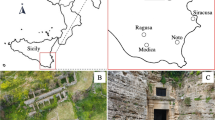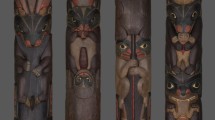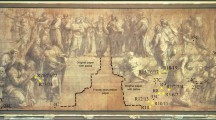Abstract
During the conservation treatment of Memling’s Christ with Singing and Music-making Angels, three panel paintings that are among the most monumental works in early Netherlandish art, the conservators came across insoluble surface layers containing calcium oxalates. A very thin and irregular layer of this type, hardly visible to the naked eye, was spread across the surface of all three panels. A much thicker layer forming an opaque and highly disfiguring crust that obscured the composition (Figs. 15.1 and 15.7) was locally present on areas of dark copper-containing paint, where multiple layers of old discolored coatings and accretions remained in place before the most recent cleaning.
This article describes the application of a wide range of analytical techniques in order to fully understand the stratigraphy and composition of the crusts on the Memling paintings. FTIR spectroscopy in transmission and reflection mode, micro-ATR-FTIR imaging and macro-rFTIR scanning, SEM-EDX, mobile XRD, and SR-μXRD showed that the crusts contained two related Ca-based oxalate salts, whewellite and weddellite, and were separated from the original paint surface by varnish, indicating that they did not originate from degradation of the original paint but from a combination of microbial action and a thick accumulation of dirt. Supported by the results from these different analytical techniques, which when used together proved to be very effective in providing complementary information that addressed this specific conservation problem, and aided by the presence of the intermediate varnish layer(s), the conservators were able to remove most of the crusts with spectacular results.
Access this chapter
Tax calculation will be finalised at checkout
Purchases are for personal use only
Similar content being viewed by others
Notes
- 1.
“Llegó a Madrid, donde, tras su limpieza, se intentó que lo comprara la Reina Maria Christina,” (Gómara 2013). Many thanks to Sara Mateu for providing the article.
- 2.
Flaking paint was noted in February and May 1901, in different areas. It was mentioned that the panels were covered by a layer of dust that adhered to the surface and diminished the brightness of the colors. Consolidation and surface cleaning with bread crumbs was proposed, but the charge made for the work was only for consolidation.
In 1952, 1977, and 1980, the panels occur in lists among other paintings that were treated, but details were not specified.
Although nothing is mentioned about the cradles, judging from their appearance, it is thought that they were attached in the 1950s or 1960s when the panels were already in the museum. In addition, a synthetic varnish (isobutyl acrylate) was found on the surface which must also have been applied in the museum.
- 3.
Infrared imaging was carried out twice: at the beginning of the project by Adri Verburg, using a phase I scanning back (4 × 5 inch) with spectral range 1000–1100 nm, and during the project by Claudia Daffara and Mattia Patti, using a multispectral scanner, spatial resolution 4 pt./mm (250 micron), InGaAs with spectral range 800–1700 nm, C.N.R.–I.N.O.A (Istituto Nazionale di Ottica Applicata).
- 4.
X-radiography was undertaken by Guido van de Voorde, Royal Institute for Cultural Heritage, Parc du Cinquantenaire 1, B-1000 Brussels.
- 5.
SEM-EDX detected copper in the blue and green paints, suggesting the use of azurite and a copper-containing green pigment (most probably originally verdigris). The grey paint layer depicting the clouds consists mainly of a mixture of lead white and a black pigment (probably a carbon-based black), mixed with a little azurite, identified by SEM-EDX and FTIR microscopy.
- 6.
http://www.esrf.eu/computing/scientific/FIT2D/. Accessed February 2017.
- 7.
http://www.bruker-axs.de/eva.html . Accessed February 2017.
- 8.
http://xrdua.ua.ac.be/. Accessed February 2017.
- 9.
- 10.
MOLAB is a mobile laboratory composed of a unique collection of portable equipment which is available to cultural heritage researchers across Europe, including art historians, conservators, and conservation scientists. The MOLAB analyses presented here were funded under the EU CHARISMA project (FP7, grant no. 228330). MOLAB can currently be accessed through the Horizon 2020 IPERION project (www.iperionch.eu, Grant No. 654028).
- 11.
In principle, whewellite and weddellite can also be distinguished on the basis of their FTIR spectra (although there is some disagreement in the literature about precise band positions), but in practice this is difficult, particularly when the salts are present in mixtures or in combinations with other compounds, see, for example, Garty et al. (2002), Conti et al. (2010), and Leroy (2016).
- 12.
Although the conservators were of the opinion that the copper-containing paint on top of the varnish layer was probably overpaint, it was left on the surface during cleaning as no certain proof for this could be found in the cross sections or on the surface of the paintings. It was not present as a continuous layer but more as local spots.
- 13.
The location of the copper oxalates suggests that some degree of migration of copper ions into adjacent layers has occurred but not all the way up into the surface crust. These results clarify why only calcium oxalates were detected at the surface of the paintings in the scrapings and using the MOLAB non-invasive reflectance FTIR equipment. It should be noted that calcium oxalates may also be present in those layers containing copper oxalates, but this cannot be confirmed because of the overlap of the spectral bands and the 900 cm−1 cutoff for the micro-ATR-FTIR imaging equipment.
- 14.
References
Borchert T (1993) Memling’s Antwerp “God the Father” with music-making angels. In: Verougstraete H, Van Schoute M (eds) Le dessin sous-jacent dans la peinture, Colloque X, September 1993, vol 1995. Le dessin sous-jacent dans le processus de creation, Louvain-la-Neuve, pp 153–168
Conti C, Brambilla L, Colombo C et al (2010) Stability and transformation mechanism of weddellite nanocrystals studied by X-ray diffraction and infrared spectroscopy. Phys Chem Chem Phys 12:14560–14566
De Nolf W, Janssens K (2010) Micro X-ray diffraction and fluorescence tomography for the study of multilayered automotive paints. Surf Interface Anal 42:411–418
De Nolf W, Vanmeert F, Janssens K (2014) XRDUA: crystalline phase distribution maps by two-dimensional scanning and tomographic (micro) X-ray power diffraction. J Appl Crystallogr 47:1107–1117
De Vos D (1994) Hans Memling. Het volledige oeuvre. Mercatorfonds, Antwerpen
Farmer V (1974) The layer silicates. In: Farmer V (ed) The infrared spectra of minerals. Mineralogical society monograph, vol 4. Mineralogical Society of Great Britain and Ireland, London, pp 331–363
Fransen B (2018) Hans Memling’s Nájera altarpiece: new documentary evidence, The Burlington Magazine. Feb 2018. CLX 101–105
Garty J, Kunin P, Delarea J et al (2002) Calcium oxalate and sulphate-containing structures on the thallial surface of the lichen Ramalina lacera: response to polluted air and simulated acid rain. Plant Cell Environ 25:1591–1604
Gianoncelli A, Castaing J, Ortega L et al (2008) A portable instrument for in situ determination of the chemical and phase compositions of cultural heritage objects. X-Ray Spectrom 37:418–123
Gómara E (2013) Las tablas Najerinas del Muro de Amberes. Arte e Historia 21:16–19
Higgitt C, White R (2005) Analyses of paint media: new studies of Italian paintings of the fifteenth and sixteenth centuries. Natl Gallery Tech Bull 26:88–97
Janssens K, Legrand S, Van der Snickt G et al (2016) Virtual archaeology of altered paintings: multiscale chemical imaging tools. Elements 12:39–44
Kahrim K, Daveri A, Rocchi P et al (2009) The application of in situ mid FTIR fibre-optic reflectance spectroscopy and GC-MS analysis to monitor and evaluate painting cleaning. Spectrochim Acta A 74:1182–1188
Kontozova-Deutsch V, Cardell C, Urosevic M et al (2011) Characterization of indoor and outdoor atmospheric pollutants impacting architectural monuments: the case of San Jerónimo Monastery (Granada, Spain). Environ Earth Sci 63:1433–1445
Lazzarini L, Salvadori O (1989) A reassessement of the formation of the patina called ‘scialbatura’. Stud Conserv 34:20–26
Legrand S, Alfeld M, Vanmeert F et al (2014) Macroscopic Fourier transform infrared scanning in reflection mode (MA-rFTIR), a new tool for chemical imaging of cultural heritage artefacts in the mid-infrared range. Analyst 139:2489–2498
Leroy C (2016) Oxalates de calcium et hydroxyapatite: des matériaux synthétiques et naturels étudiés par techniques RMN et DNP. PhD thesis in Chemistry, Université Pierre et Marie Curie, Paris. https://tel.archives-ouvertes.fr/tel-01443727. Accessed Feb 2017
Matteini M, Moles A, Lanterna G et al (2002) Characteristics of the materials and techniques. In: Ciatti M, Seidel M (eds) Giotto. The crucifix in Santa Maria Novella. Edifir, Florence, pp 387–403
Mendes N, Lofrumento C, Migliori A et al (2008) Micro-Raman and particle-induced X-ray emission spectroscopy for the study of pigments and degradation products present in 17th century coloured maps. J Raman Spectrosc 39:289–229
Miliani C, Rosi F, Sgamellotti A et al (2010) In situ noninvasive study of artworks: the MOLAB multitechnique approach. Acc Chem Res 43:728–738
Monico L, Rosi F, Miliani C et al (2013) Non-invasive identification of metal-oxalate complexes on polychrome artwork surfaces In reflection mid-infrared spectroscopy. Spectrochim Acta A 116:270–280
Noble P, Van Loon A (2007) Rembrandt’s Simeon’s song of praise, 1631: pictorial devices in the service of spatial illusion. Art Matters 4:19–35
Potgieter-Vermaak S, Godoia R, Van Grieken R et al (2005) Micro-structural characterization of black-crust and laser cleaning οf building stones by micro-Raman and SEM techniques. Spectrochim Acta A 61:2460–2467
Rampazzi L, Andreotti A, Bonaduce I et al (2004) Analytical investigation of calcium oxalate films on marble monuments. Talanta 63:967–977
Salvadó N, Butí S, Nicholson J et al (2009) Identification of reaction compounds in micrometric layers from gothic paintings using combined SR-XRD and SR-FTIR. Talanta 79:419–428
Salvadó N, Butí S, Cotte M et al (2013) Shades of green in 15th century paintings: combined microanalysis of the materials using synchrotron radiation XRD, FTIR and XRF. Appl Phys A 111:47–57
Solé V, Papillon E, Cotte M et al (2007) A multiplatform code for the analysis of energy-dispersive X-ray fluorescence spectra. Spectrochim Acta B 62:63–68
Spring M, Higgitt C (2006) Analyses reconsidered: the importance of the pigment content of paint in the interpretation of the results of examination of binding media. In: Nadolny J (ed) Medieval paintings in northern Europe: techniques, analysis, art history. Studies in commemoration of the 70th birthday of Unn Plahter. Archetype, London, pp 223–229
Van der Snickt G, Miliani C, Janssens K et al (2011) Material analyses of ‘Christ with singing and music-making Angels’, a late 15th-C panel painting attributed to Hans Memling and assistants: Part I. non-invasive in situ investigations. J Anal At Spectrom 26:2216–2229
Van der Snickt G, Janssens K, Dik J et al (2012) Combined use of synchrotron radiation based micro-X-ray fluorescence, micro-X-ray diffraction, micro-X-ray absorption near-edge, and micro-Fourier transform infrared Spectroscopies for revealing an alternative degradation pathway of the pigment cadmium yellow in a painting by Van Gogh. Anal Chem 84:10221–10228
Van Grieken R, Gysels K, Hoornaert S et al (2000) Characterization of individual aerosol particles for atmospheric and cultural heritage studies. Water Air Soil Pollut 123:215–228
Van Loon A (2008) Color changes and chemical reactivity in seventeenth-century oil paintings. Dissertation, University of Amsterdam. MOLART Reports, vol. 14
Vandenbroeck P (1985) Catalogus schilderijen 14e en 15e eeuw. Ministerie van de Vlaamse Gemeenschap/Koninklijk Museum voor Schone Kunsten, Antwerpen, pp 138–143
Zoppi A, Lofrumento C, Mendes N et al (2010) Metal oxalates in paints: A Raman investigation on the relative reactivities of different pigments to oxalic acid solutions. Anal Bioanal Chem 397:841–849
Acknowledgments
A conservation project this large involves many people. Many thanks to Ineke Labarque, Régine Wittermann, Jean Albert Glatigny, Sara Matteu, Madeleine ter Kuile, Greta Toté, the advisory committee, and all colleagues from the conservation studio. We are indebted to the staff of the P06 beamline of the PETRA III facility and to DESY for providing the beam time for the synchrotron radiation-based measurements. KJ, GvdS, FV, and SL acknowledge financial support from the University of Antwerp Research Council via SOLARPAINT and other projects, the Fund Baillet Latour, and the Fund for Scientific Research (FWO), Brussels. CH and MS acknowledge the assistance of their colleague David Peggie. The conservation of the panels was supported by the Friends of the KMSKA and Interbuild NV, and the associated research was supported by the Baillet Latour fund.
Author information
Authors and Affiliations
Corresponding author
Editor information
Editors and Affiliations
Rights and permissions
Copyright information
© 2019 Crown
About this chapter
Cite this chapter
Klaassen, L. et al. (2019). Characterization and Removal of a Disfiguring Oxalate Crust on a Large Altarpiece by Hans Memling. In: Casadio, F., et al. Metal Soaps in Art. Cultural Heritage Science. Springer, Cham. https://doi.org/10.1007/978-3-319-90617-1_15
Download citation
DOI: https://doi.org/10.1007/978-3-319-90617-1_15
Published:
Publisher Name: Springer, Cham
Print ISBN: 978-3-319-90616-4
Online ISBN: 978-3-319-90617-1
eBook Packages: Chemistry and Materials ScienceChemistry and Material Science (R0)




